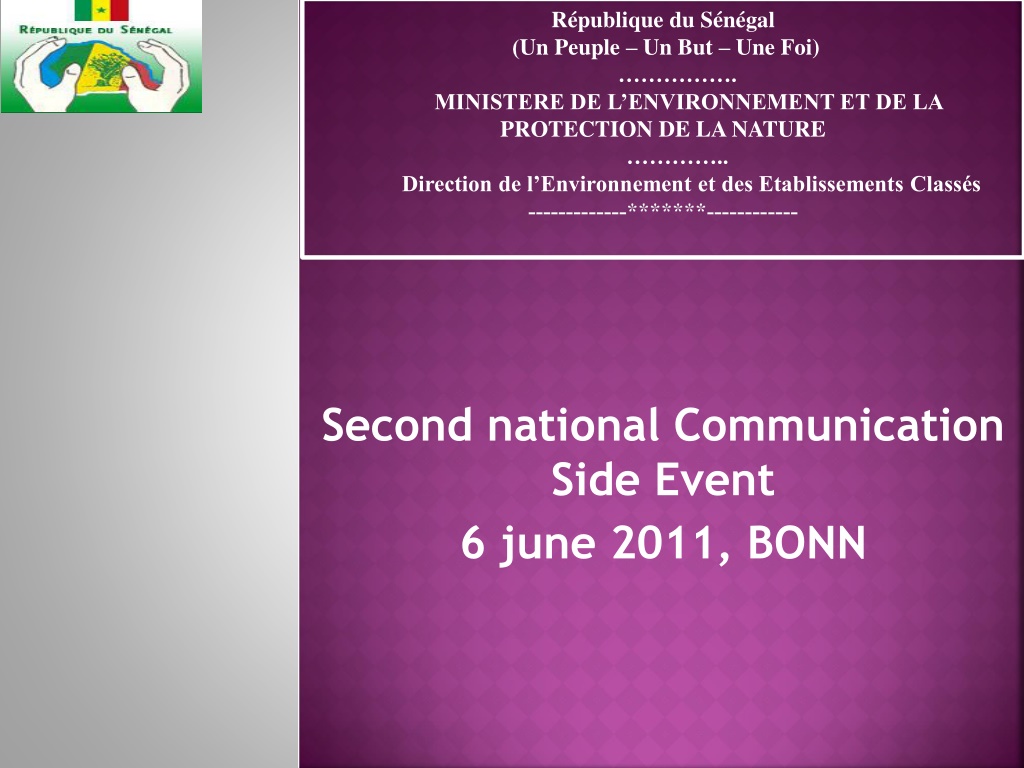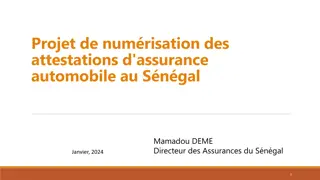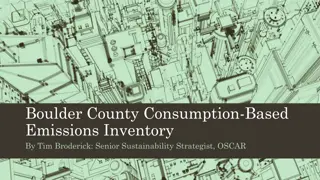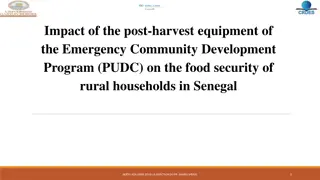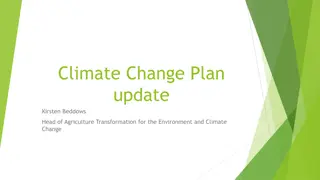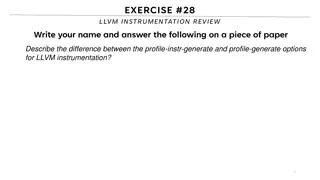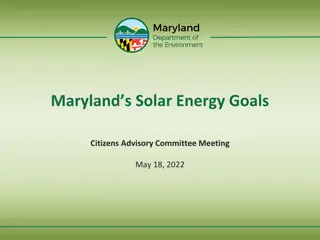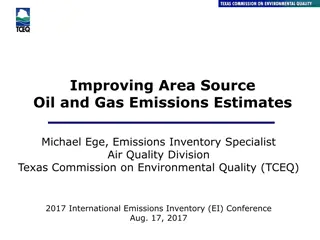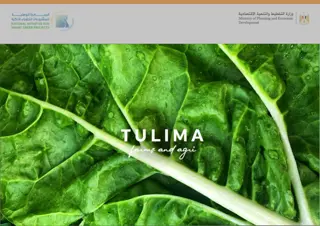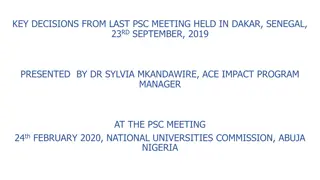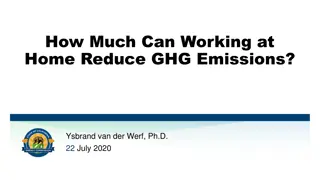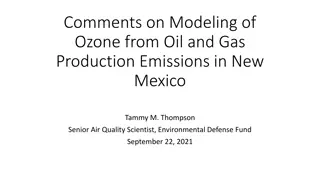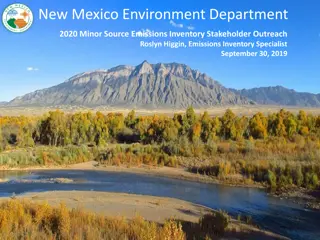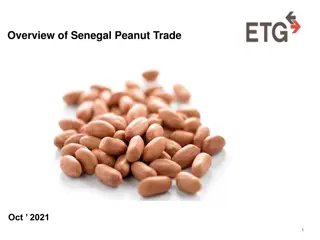Environmental Profile of Senegal: A Closer Look at Emissions and Climate Impact
Senegal, located in West Africa, faces environmental challenges reflected in its emissions profile and climate characteristics. With a focus on greenhouse gas inventory and primary sector growth, this overview sheds light on the country's environmental landscape.
Download Presentation

Please find below an Image/Link to download the presentation.
The content on the website is provided AS IS for your information and personal use only. It may not be sold, licensed, or shared on other websites without obtaining consent from the author. Download presentation by click this link. If you encounter any issues during the download, it is possible that the publisher has removed the file from their server.
E N D
Presentation Transcript
Rpublique du Sngal (Un Peuple Un But Une Foi) . MINISTERE DE L ENVIRONNEMENT ET DE LA PROTECTION DE LA NATURE .. Direction de l Environnement et des Etablissements Class s -------------*******------------ Second national Communication Side Event 6 june 2011, BONN
SENEGAL IN AFRICA Senegal
NATIONAL CIRCUMSTANCES Senegal is located at the western end of the African continent between 12 and 17 of Northern latitude Nord and 11 and 18 Western longitude; The total area of Senegal is 196. 722 sq. km; 700 km long are mainly of three types: sandy coasts (300 Km), rocky coasts (174 Km), and mangrove estuaries (234 Km); The climate is Sudano-Sahelian. It is characterized by the alternation of a dry season from November to May and a rainy season from June to October.
NATIONAL CIRCUMSTANCES the Senegalese population was estimated at 10. 564. 303 inhabitants in 2004 from 9 385 417 in 2000 (reference year for this national report); This population is mainly rural or 58.5% (or an urbanization rate of 41.5%). More than half of city dwellers (54.0%) live in Dakar which has a strong migration. Indeed out of the 2, 333, 420 inhabitants in Dakar; The real GDP growth was estimated at 6.1% in 2005 against 5.6% in 2004.
NATIONAL CIRCUMSTANCES The primary sector recorded a 12.2% growth in 2005 against 2.7% in 2004 and was mainly driven by the agricultural sub-sector. The growth of the energy sub-sector was estimated at 9.9% despite the difficulties related to the hikes in oil prices. The impact of the rising oil price was limited by measures to curb the price of fuel which is the main intermediate consumption in electricity production.
I. GREENHOUSE GAS INVENTORY CO2, CH4, N2O, NOx, CO, VNMCO and the Sulfur Dioxide (SO2). Emissions of other gases such as hydro fluorocarbons (HFCs) per fluorocarbons (PFCs) and sulfur hexafluoride (SF6) are negligible. Distribution of total emissions per Gas Distribution of CO2 emissions per sector
I. GREENHOUSE GAS INVENTORY Converted to sequestrate CO2 equivalent these emissions are divided as follows: 49% for energy, 37% for agriculture, 12% for waste and 2% for industrial processes. The total of these emissions is 16. 890.92 Gg; or an emission of 1.8 tone of CO2 per capita (for a population of 9 385 417 inhabitants). Taking into account the 10. 587 Gg of CO2emissions sequestrated in the forestry sector, the emission rate per capita becomes 0.67 tone. Distribution of total emissions in CO2equivalent
II. VULNERABILY AND ADAPTATION 2.1.Analysis of the agricultural vulnerability The current vulnerability is particularly related to the high dependency of the Senegalese agriculture on a rainfall that gets dwindles over time and which interannual variability is difficult to predict. Consequences : A greater evaporative demand of plants; A slowdown of growth impacting on the yields; Negative effects on the flooding of traditional rice-growing areas by brackish waters.
II. VULNERABILY AND ADAPTATION 2.2. Water resources Water demand in urban areas: a study case of the Dakar region Projections for increased demand are based on assumptions of population growth and the monitoring of the actually charged volumes.
II. VULNERABILY AND ADAPTATION 2.2. Water resources Projected population growth in Dakar Year 2000 2010 2020 2030 Population Growth rate estimated at 2.0%) 2, 132,, 000 inhabitants 2, 696, 000 inhabitants 3, 220, 000 inhabitants 3, 674, 000 inhabitants Estimated consumption 134, 918 cubic metres 175, 240 cubic metres 209, 300 cubic metres 238, 810 cubic metres
II. VULNERABILY AND ADAPTATION 2.2. Water resources Water demand in regions Projections of water demand in the regions were made for the the 2001-2010 Urban Water Investment Plan . They build on population growth, the coverage rate (100% in 2005 and 100% by private connections in 2020) and water allocations. By 2020, projected charges would be about 228, 044 cubic metres daily. The populations coverage rate increased from 7 litres daily per capita in 1981 to 28 litres daily per capita (in 2009). The coverage rate of water needs in rural areas is about 64%.
II. VULNERABILY AND ADAPTATION 2.3. Costal aera The Senegalese coastal area is attacked by coastal erosion which in some sites poses a real threat particularly in terms of economic and biodiversity losses together with the destruction of habitats. The causes of coastal erosion are highly variable and may differ from one sector to the next. Vulnerability to each erosion factor has been assessed. It is the product of the intensity and urgency compared to actions taken in order to limit the impacts of the factor. Adding the vulnerabilities of a site to the various factors made it possible to have the vulnerability of the site to erosion.
II. VULNERABILY AND ADAPTATION 2.4. Health The recurrent occurrence of yellow fever epidemics in the centre-western and south-eastern regions was noted. Geographical distribution of yellow fever cases between 1965 and 2006
STRATEGY TO ADAPT TO CLIMATE CHANGE Thrust 1: Development of appropriate knowledge on the effects of climate change and technology transfer Thrust 2 : Strengthening the prevention and fight against climate shocks Thrust 3 : Promoting a sustainable management of natural resources. Strategy 1: Promoting a responsible resource conservation fishing Strategy 2: Development of marketing strategies Strategy 3 : Promoting a sustainable food and cash aquaculture.
III. MITIGATION Green Has emissions mitigation analysis has been made in the five sectors. Energy sector, the analyse has been developed through an analysis of the current policy in the sector more specifically the household sub-sector which energy consumption is the highest (42%) has been analyzed with the LEAP (Long-range Energy Alternatives Planning System) model.
III. MITIGATION The proposed mitigation options include: The management of the energy demand in the sectors of electricity. domestic fuel and transport ; The management of the supply through the implementation and strengthening of actions aimed at optimizing the energy supply systems. The analysis of these options has helped establish the following evolution of emissions in the sector.
III. MITIGATION In the mitigation scenario the emissions will stand at 14. 540 Gg CO2 in 2010 against 14, 904 Gg in the reference scenario or about 364. 000 tE-CO2of GHG avoided, accounting for 2.44% of emissions in the energy sector which seems relatively significant. By 2020 GHG emissions due to energy would account for 17, 281 Gg CO2emissions in the mitigation scenario against 21, 057 Gg CO2 emissions in the reference scenario or about 3, 776 Gg CO2emissions or 18% of emissions in the energy sector.
III. MITIGATION Economic impact Investments planned under the Electric Demand Control (EDC) program are estimated at 300 billion CFA Francs during 2009-2020. This program will help save up to 709 billion CFA Francs over the same period. Moreover, the recovery of carbon credits will incur financial gains estimated at 11 billion CFA francs. For the improved stoves extension program investments will be about 16 billion CFA Francs during 2009-2020 and resources from carbon credit recovery estimated at 25 billion CFA Francs. Total investments will represent 316 Billions of CFA Francs over 2009-2020 with a carbon credit recovery estimated at 36 billion CFA Francs. Additionally, mitigation analysis in the household sub-sector with the massive introduction of improved stoves, the development of some projects: 100MW water plants, construction of a 20 MW solar power plant and the reforestation of 430 million hectares show the environmental significance of these programmes due to the large amounts of carbon avoided. The implementation of these projects would help not only reduce GHG emissions but address some energy issues.
III. MITIGATION Industrial processes sector the proposed mitigation options include: Improving the quality of clinker; Using good practices to improve processes; Developing combined technologic options. Agricultural sector good practices are proposed in order to reduce the GHG emissions. These are: Promoting new land management methods ; Promoting the burial of crop residues instead of incineration ; Promoting agroforestry ;
III. MITIGATION With respect to the Land-Use and Land-Use Change sector despite the very insignificant quantity of emitted carbon (32 Gg CO2) for a very high absorption capacity (10. 587 GgCO2), a mitigation analysis was made with the COMAP model. Several mitigation programs were identified with a special option for the enriched grazing in the groundnut basin
III. MITIGATION Waste the targeted mitigation strategies are: Solid waste in dumps The Mbeubeus Dump closure and rehabilitation project ; The Sindia CET (Technical Burial Centre) completion and operation mining project; The establishments of a technical order on the CET. taking into account the management of the biogas. Processed wastewater Optimizing the operation of processing basins and reducing methane emissions ; The implementation of the rural sanitation under the PEPAM ; Addressing a component biogas recovery in the rural sanitation component under the PEPAM ; Conducting technical studies and/or implementing biogas recovery projects in the slaughterhouses in Dakar, Thies and Touba and on the location of the future national slaughterhouse.
IV. CROSS CUTTING ISSUES The capacity building components has a key place in implementing the convention on the climate and other Rio Conventions.
KEY CHALLENGES AND LESSONS LEARNT AND/OR INNOVATIONS AND BEST PRACTICES In the process of preparation of second and/or third national communication(s) Important to have more meeting with all project coordinator maybe annual meeting to assess project and make recommendation on ongoing activities and also to have a pair review. In use of the guidelines and methodologies Ways to overcome/address the challenges: Mitigation: Develop our NAMAS, Vulnerability: Assement the link between climate change, mitigation and gender.
